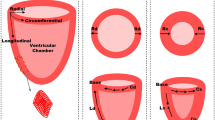Abstract
The inadequacies of currently employed methods for assessment of cardiac mechanics are discussed, and the need for development of more intrinsic assessment parameters is emphasised. To this end, a new technique is presented to enable determination of regional mechanical constitutive properties of the myocardium during diastole; this technique has been originally named left-ventricular mechanomyocardiography (or l.v.-m.m.c.g.). The data required for implementation of the techniques consist of left-ventricular sequential dynamic geometry and associated recorded chamber pressure. The method entails matching of the inner-boundary deformations of the instantaneous finite-element model of the left ventricle (which is loaded by the recorded instantaneous incremental pressure) with the actual instantaneous endocardial deformations (as derived from either cineangiocardiography or 2-dimensional echocardiography), to determine the regional distribution of the Young's modulus Ene and the incremental stresses Δσne (and hence the total stress σne=∑nΔσne) of the myocardial elements. The mechanical constitutive properties of the myocardial elements can be then characterised by the constitutive relation Ene=a+bσ. The constitutive parameters a and b have typical ranges for normal and pathological (ischaemic and infarcted) myocardial elements and hence can be employed to distinguish diseased elements. The values of a and b are calculated for normal and pathological subjects and their normal and pathological ranges are presented.
Similar content being viewed by others
References
Anderson, W. A., Arnold, J. T., Clark, L. D., Davids, W. T., Hillard, W. J., Lehr, W. J. andZitelli, L. T. A new real-time phase-array sector scanner for imaging the entire adult heart.Ultrasound in medicine,3B, 1547–1558.
Baker, C. M. andPilkington, T. C. (1974) The use of time dependent models in inverse electrocardiography.IEEE Trans.,BME-21, 460–468.
Demiray, H. (1976) Stresses in ventricular wall. Paper No. 76-APM-31, ASME Meeting, Utah, June, 1976.
Ghista, D. N. andVayo, H. W. (1969) The time varying elastic properties of the left ventricular muscle',Bull. Math. Biophys.,31, 75–92.
Ghista, D. N. (1974) Rheological modelling of the intact left ventricle. InCardiac Mechanics (Eds.I. Mirsky, D. N. Ghista andH. Sandler, Wiley-Interscience, New York.
Ghista, D. N., Sandler, H. andVayo, W. H. (1975a) Elastic modulus of the human intact left ventricle-determination and physiological interpretation.Med. and Biol. Eng.,13, 151–161.
Ghista, D. N., Rao, B. H. andAdvani, S. H. (1975b)In vivo elastic modulus of the left ventricle: its determination by means of a left ventricular model and its physiological significance and clinical utility.Med. and Biol. Eng.,13, 162–170.
Ghista, D. N. andHamid, S. (1977) Finite element analysis of the human left ventricle.Computer Programs in Medicine,7, 219.
Glantz, S. A. (1977) A three-element description of a muscle with viscoelastic passive elements.J. Biomech.,10, 5–20.
Harrison, D. C., Sandler, H. andMiller H. A. (1975) Cardiovascular, imaging and image processing—theory and practice. Society of Photo-optical instrumentation engineers, Palo Verdes Estates, California, 245–302.
Ingles, N. B., Daughters, G. T., Stinson, E. B. andAlderman, E. L. (1975) Measurement of midwall myocardial dynamics in intact man by radiography of surgically implanted markers.Circulation,52, 859–867.
Janz, R. F., Kubert, B. R., Mirsky, I., Korecky, B. andTaichman, G. C. (1976) Effect of age on passive elastic stiffness of rat heart muscle.Biophys. J., 281–290.
Mirsky, I., (1973) Ventricular and arterial wall stress based on large deformation analyses.Biophys. J.,13, 1141–1159.
Nikravesh, E. P. (1976) Optimisation in finite element analysis, with special reference to 3-dimensional left ventricular dynamics. Ph.D. thesis, Tulane University.
Pao, Y. andRitman, E. C. (1977) Global's Young modulus of urethane plastic cast of left ventricular myocardium calculated from Roentgen angiographic silhouettes.10, 133–140.
Author information
Authors and Affiliations
Rights and permissions
About this article
Cite this article
Ghista, D.N., Ray, G. & Sandler, H. Cardiac assessment mechanics: 1 Left ventricular mechanomyocardiography, a new approach to the detection of diseased myocardial elements and states. Med. Biol. Eng. Comput. 18, 271–280 (1980). https://doi.org/10.1007/BF02443379
Received:
Accepted:
Issue Date:
DOI: https://doi.org/10.1007/BF02443379




